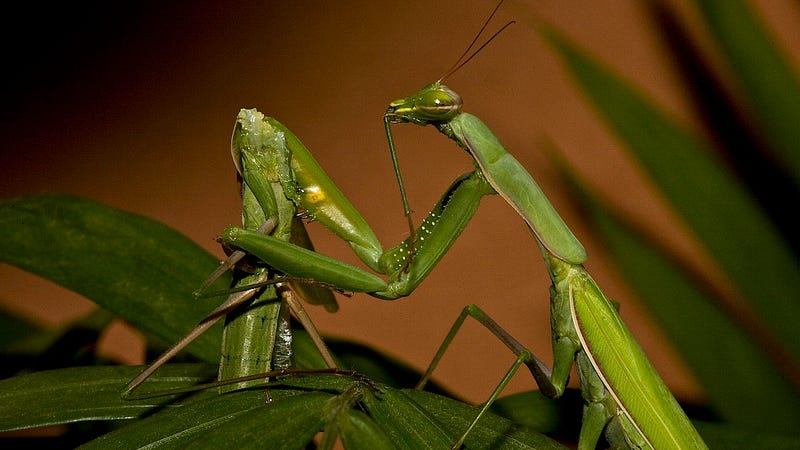
(琉球新報 2018年4月27日)
オスは要らない。メスだけ増えろ!自然界の不思議ですね!昆虫の不思議です!メスのカマきりのオス殺しは有名ですが、細菌レヴェルでオス殺しがあるのですね。不思議です。
************************
https://www.gizmodo.jp/2016/07/75_6.html
なんでメスのカマキリは交尾中にオスをたべちゃうのか
メスのカマキリは交尾中にパートナーを殺して食べる習慣があります。オスにとってはたまったもんじゃない、と思うかもしれませんが、研究によればこの愛のための自己犠牲は生殖に有利なんだそうですよ。
カマキリの交尾中の共食いは広く記録されていますが、その理由に関しては科学者たちにも意見の分かれるところでした。そんな中で「Proceedings of the Royal Society B」に発表された新たな研究では、交尾後にオスのパートナーを食べたメスのほうが、そうでないものよりも多くの卵を産むことを示しています。しかも、ちゃんと食べられたオスは子供の役に立つんですよ。
この研究の共同執筆者で、フロリダにあるニューヨーク州立大学の科学者であるWilliam Brownさんはこうまとめています。「つまり交尾のカニバリズムは、オスにとっては子孫を残すための投資というわけです」
カマキリの交尾の約25%でオスは死に至ります。メスはたいていの場合、まずパートナーの頭を噛みちぎり、下のほうへと進んでいきます。驚くことに、これがメスのカマキリの交尾期の食事の63%ほどを占めるんです。科学者たちは、これは生殖する重要な時期に手早く栄養を取る方法だとみていますが、これに関しては確かな証明はありません。
生殖時期に栄養を取るためなのか、それを確かめるため、科学者たちは追跡可能な放射性アミノ酸をコオロギの中に入れ、オスのカマキリたちに食べさせました。それぞれのオスはその後メスとつがいにさせられます。そのうち半分は食べられる前に救出、そのうちの半分は食べられるがままに…。そして研究者たちは個々のメスの生殖がどうなるのか見ていきます。
メスの体の中の放射性プロテインの流れをみてみると、メスに食べられたオスが役立っていることが発見されました。食べられたオスからは、ほぼ90%のアミノ酸がメスにわたっていました。一方、オスが食べられなかった場合は、メスにわたったアミノ酸は、射精によってわたされた約25%のみ。
大部分のアミノ酸はカマキリの赤ちゃんへと引き継がれました。つまりアミノ酸はメスの中で完全に代謝されることがなかったということ。これが意味するのは、オスの射精に加え、オスの体の組織もまた卵を産み出すのに使われているということなんです。自らの死により子供たちに栄養を与えるというわけなんですね。
結果として、パートナーを食べたメスは平均で約88個、食べていないほうは平均で約35個と、オスを食べたほうがより多くの卵を産みました。これは大きな違いで、オスとしても自分が食べられたほうが自らの子孫を残すのに有利だということです。
とはいえ、それは人生で一度交尾をするとしたらのはなし。食べられなかったオスは複数回交尾することも可能なわけで、オスとしてはこれもまた生殖には有利なわけです。進化における葛藤ですよね。研究者たちはこの点に関してもっと研究を進めるとのことです。
交尾に際した共食いは、一部の蜘蛛にもみられます。しかし、それらの蜘蛛では交尾後に生殖器は二度と使えなくなってしまいます。一方、カマキリのオスの方は複数回の交尾が可能なのです。
image by Oliver Koemmerling
source: Proceedings of the Royal Society B
George Dvorsky - Gizmodo US[原文]
(abcxyz)
Why Female Praying Mantises Devour Their Partners During Sex

Female praying mantises have a habit of killing and eating their partners during sex, which sucks for the male. Or does it? A fascinating new study shows this sacrifice is actually giving the males a distinct reproductive advantage.
In praying mantises, around 25 percent of all sexual encounters result in the death of the male. The female typically begins by biting off her partner’s head, and she works down from there. Incredibly, this comprises about 63 percent of the female’s diet during the mating season. Scientists have speculated that it’s a way for the female to record a quick meal at a critical point in her reproductive life cycle, but this claim has largely remained unproven.
To see if this is actually the case, the researchers embedded traceable radioactive amino acids into crickets, which were subsequently fed to a population of male mantises. Each of these males was then paired with a female. Half of them were rescued from their two-faced lovers before cannibalism could take place, while the other half... well you know what happened to the other half. The researchers then set about the task of studying the reproductive success of each female involved.
By following the flow of radioactive proteins through the bodies of the females, the scientists could track the contribution of the recently-devoured male. Males who were devoured passed on nearly 90 percent of their tagged amino acids, while those who survived passed on about 25 percent—all of which were delivered via their ejaculate.
A significant portion of the amino acids was passed down to the baby mantises, which means they weren’t fully metabolized by the female. This means that, in addition to the male’s ejaculate, his body tissue is being used to produce eggs. The male—by virtue of his death—is providing nourishment to his offspring.
Those females who ate their partners produced more eggs than those who did not. On average, cannibalistic females produced about 88 eggs, whereas those who didn’t eat their partners produced about 37. That’s a big difference, one that gives cannibalized males a distinct reproductive advantage.
Well, at least in one-off situations. Males who survive mating encounters can potentially reproduce multiple times, which can also be seen as a reproductive advantage. Clearly, there’s an evolutionary tension here, one the scientists will have to look into a bit further.
Sexual cannibalism has also been observed in some spiders. But unlike these arachnids, whose reproductive organs become permanently damaged after sex, male mantises are able to copulate multiple times.




















